Determine which strategies are strictly (and weakly) dominated.
R is strictly dominated by L
M is weakly dominated by U
Public good provision. N residents. They want to build a park. Person i contributes m_i>= 0 .
Total contribution M=m_1+m_2+...+m_N
Player i's benefit from the park is \sqrt{M}-m_i.
What is socially optimal level of public good?
What is the symmetric Nash equilibria in pure strategies?
Social optimum: M=N^2/4
Nash equilibrium: m_i=1/(4N)
What are Nash equilibria in pure and mixed strategies?
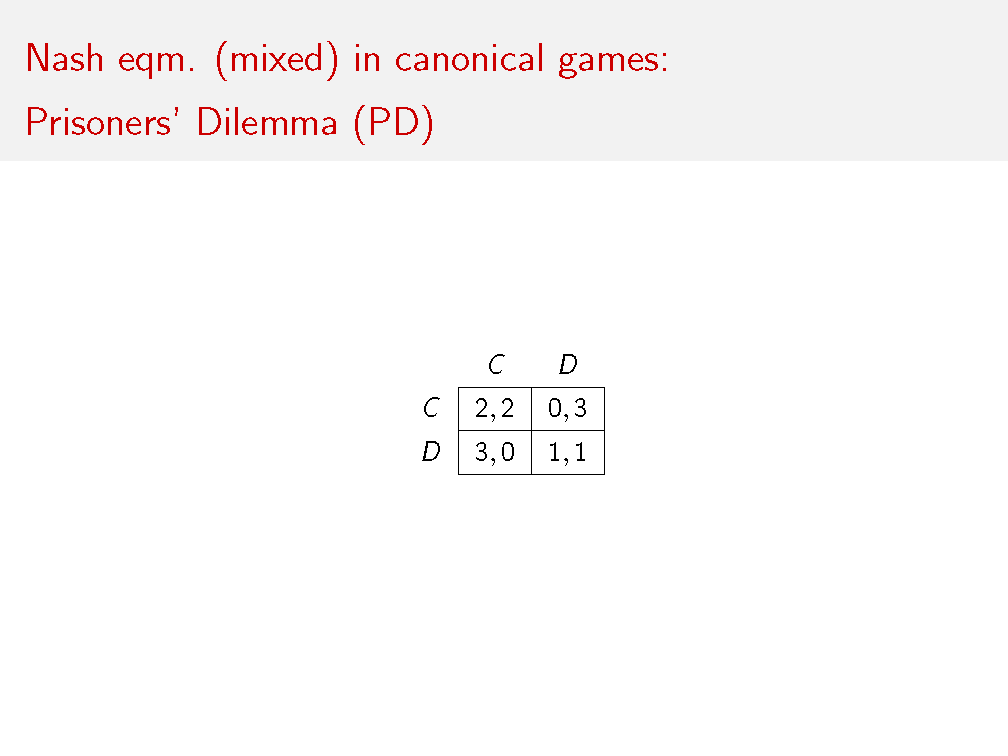
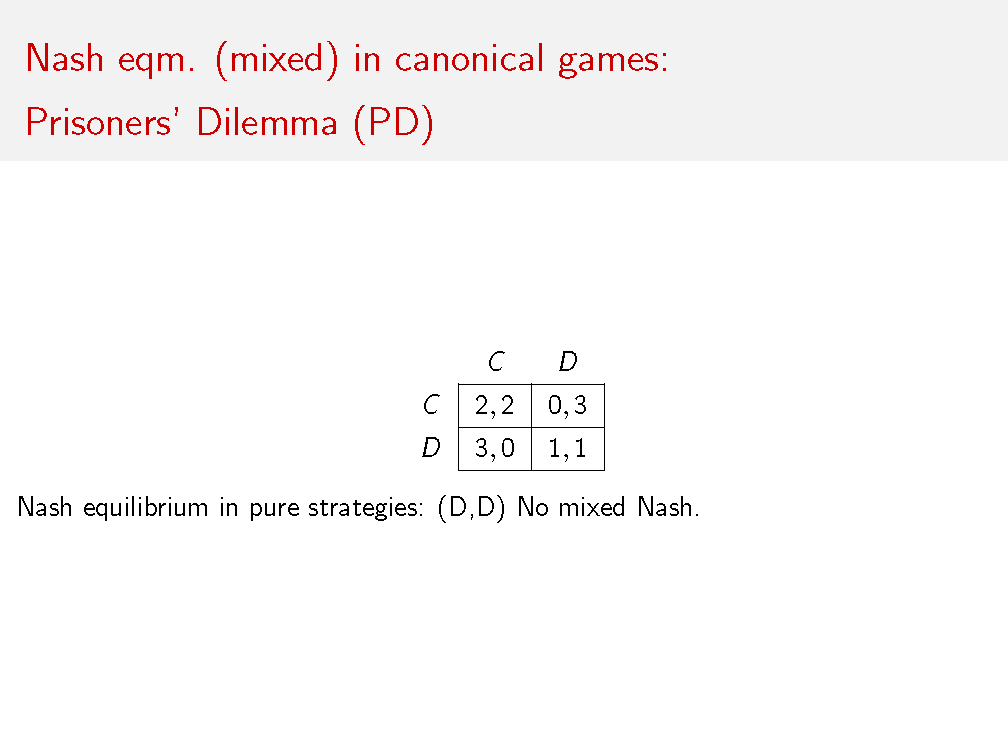
Find all pure strategy subgame perfect equilibria.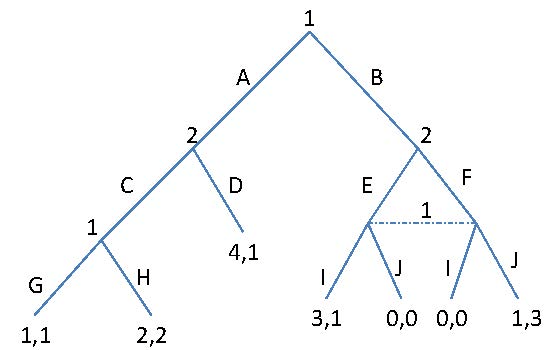
Subgame perfect equilibria in pure strategies are (AHJ, CF) and (BHI, CE)
Identify the strategies that survive the process of elimination of strictly dominated strategies.
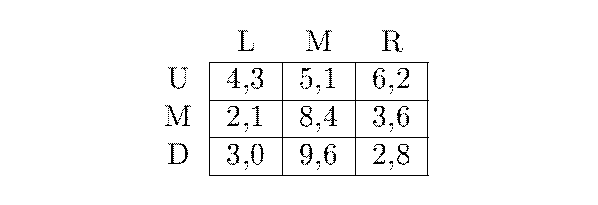
{U,L}
Network effects
N=100 players contemplating buying: Mac or Windows.
The payoff from Mac:
100+2(m-1)
where m is the total number of players who chose Mac.
The payoff from Windows:
2(w-1)
where w is the total number of players who chose Windows.
Network effect: The value of an operating system increases when more people use it.
What are Nash equilibria in pure strategies?
All play "Mac" is Nash.
All play "Windows" is Nash as
100<2*(N-1)
What are all Nash Equilibria in mixed strategies?

{W,W}, {G,\alpha G + (1-\alpha)W}, \alpha\leq 1/2
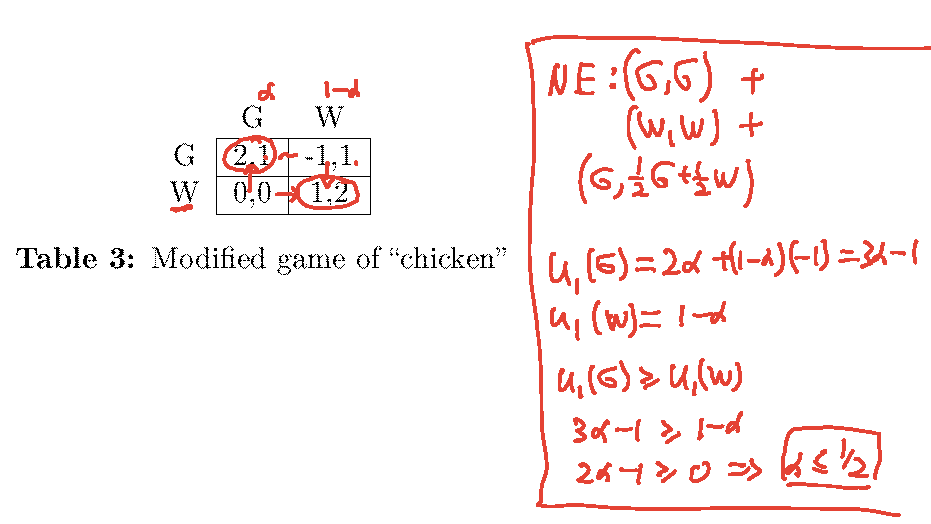
Voting. Players 1, 2, 3 decide among alternatives A, B, and C. B is the "status quo" and alternatives A and C are "challengers".
• Stage 1: players vote for either A or C, and the majority wins.
• Stage 2: players vote for either the winner of stage 1 or B, the majority wins.
Players vote simultaneously in each round. The players care only about the alternative that is finally selected.
• The payoffs for alternatives (A,B,C) for agent 1 are (2,0,1), for agent 2 are (1,2,0), and for agent 3 (0,1,2).
Find a subgame-perfect equilibrium of the game. What alternative wins?
Stage 2a (A vs B); players vote: 1-A, 2-B, 3-B
Stage 2b (C vs B); players vote: 1-C, 2-B, 3-C
Stage 1 (C vs A (eff C vs B)): 1-C, 2-A, 3-C
• There is a class of 10 students. They submit a real number between 1 and 100.
• The winner is a student(s), whose number is the closest to the 3/2 of the class average.
Provide Steps 1 and 2 of the process of elimination of weakly dominated stratgies. Identify the set of strategies that survive the process.
Step 1: 3/2 average in [3/2,150]; survive [3/2,100];
Step 2: 3/2 average in [9/4,150]; survive [9/4,100];
Step 3: ...
All students naming 100 is the only strategy that survivies the process.
Congestion effect: Value of an option decreases when more people choose it.
N=100 riders trying to go downtown from Shadyside. Two routes: Fifth Ave or Bigelow Blvd.
Payoff from Fifth: 101-(f-1), where f is the number of riders who chose Fifth ave.
Payoff from Bigelow: 80-(b-1), where b is the number of players who chose Bigelow.
What are Nash equilibria in pure strategies?
The riders do not want to switch to the other route if
101-(f-1)>=80-(b+1-1)
80-(b-1)>=101-(f+1-1)
Therefore, 22>=f-b>=20 or 122>=2f>=120. NE (f,b)=(60,40),(f,b)=(61,39).
What is the subgame perfect equilibrium in (purely) mixed strategies?

Subgame perfect equilibrium in (purely) mixed strategies (P1:AH, 3/4I+1/4J; P2:C, 1/4E+3/4F)
• Game 21. There are 2 players and a stack of 21 cards.
• Players alternate taking out cards.
• At each turn, the corresponding player can take out 1, 2, or 3 cards.
• The player who takes out the last card loses the game (payoff 0). The other wins (payoff 1).
• Does your team want to be player 1 or player 2? What is subgame perfect equilibrium? Explain.
Let us assume only
There is 1 card: P1 loses, P2 wins
2,3,4 cards: P1 wins by taking 1,2 or 3 cards, P2 loses
5 cards: P1 loses, P2 wins
6, 7, 8 cards: P1 wins, P2 loses
....
P1 loses at 1,5,9,13,17,21; at the other cases P1 wins. General strategy in SPE is to pick # cards such that there are 1,5,9... cards left.